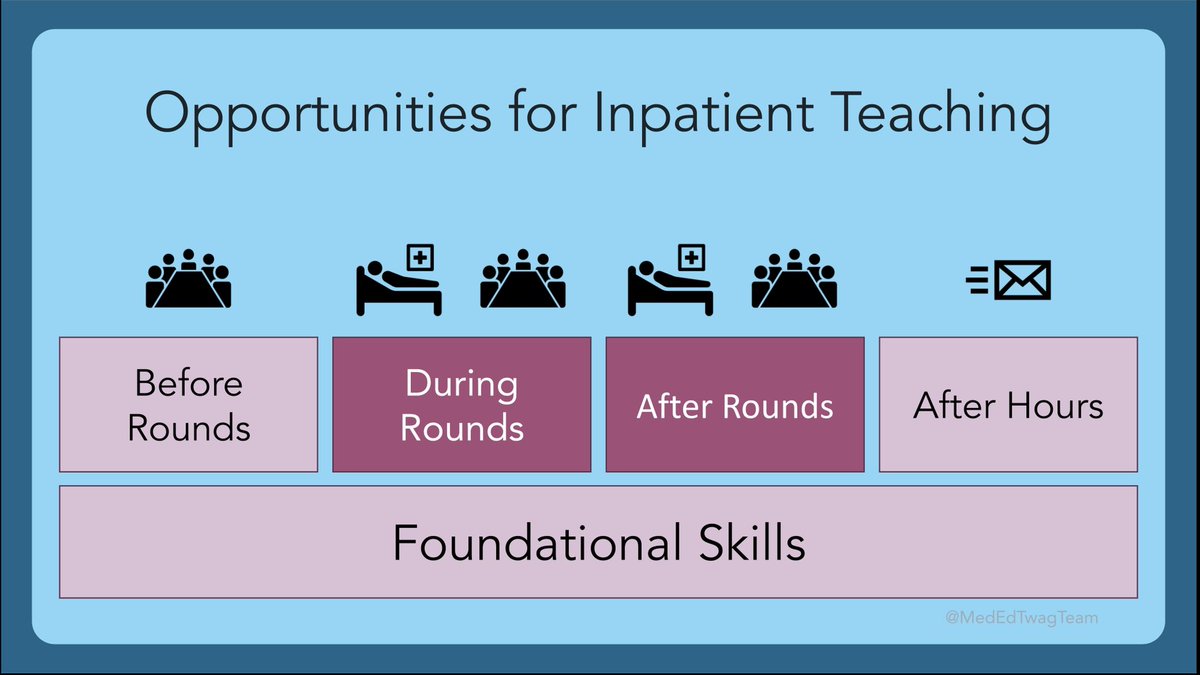1/ Your intern on rounds: “I’m worried about Ms. H & think we need a family meeting.”
You mentally check your schedule to decide where to fit a 30-60 min family meeting AND make it a good learning experience.
#MedEdTwagTeam is back w tips on the latter!
#MedTwitter #MedEd
You mentally check your schedule to decide where to fit a 30-60 min family meeting AND make it a good learning experience.
#MedEdTwagTeam is back w tips on the latter!
#MedTwitter #MedEd

2/ As a reminder, we are continuing our discussion about opportunities for inpatient teaching after rounds. We return to the bedside this week to discuss teaching around family meetings 

3/ What are your objectives for using the family meeting as a method of teaching?
Common areas for intentional skill-building with family meetings are highlighted 👇🏼
Common areas for intentional skill-building with family meetings are highlighted 👇🏼

4/ Before the family meeting gather your team for a pre-brief to:
- Decide who is leading
- Agree on a skill to observe
- Review agenda & pt care goal
- ✅ are necessary members of the interdisciplinary team present
- Anticipate challenging scenarios. Consider a brief role pla
- Decide who is leading
- Agree on a skill to observe
- Review agenda & pt care goal
- ✅ are necessary members of the interdisciplinary team present
- Anticipate challenging scenarios. Consider a brief role pla
5 / If you need a framework for family meetings, @vitaltalk is a great resource for communication around serious illness. Check link👇🏼 for a video & step-wise approach
The guide can also serve as a framework for feedback on the meeting
vitaltalk.org/topics/conduct…
The guide can also serve as a framework for feedback on the meeting
vitaltalk.org/topics/conduct…
6/ If you have other learners joining but not leading the meeting, how do you keep them from drifting off?
Assign roles for learners to practice their skills of observation & peer feedback.
Assign roles for learners to practice their skills of observation & peer feedback.

7/ During the meeting, sit back, let your learners do the talking, & make your observations.
8/ If you feel an aspect of communication was skipped or could be improved/clarified, gently step in and role model what to say.
An example of further exploring patient wishes 👇🏼
An example of further exploring patient wishes 👇🏼

9/ Post family-meeting, make sure to debrief!
✨Ask for reflections about the meeting
✨Did the team learn anything new about the pt / family members?
✨Have observing learners provide peer feedback
✨Provide your own feedback
✨Ask for reflections about the meeting
✨Did the team learn anything new about the pt / family members?
✨Have observing learners provide peer feedback
✨Provide your own feedback

10/ With a little pre-planning & time set aside before, during, and after your family meeting, there can be plenty to learn & teach about your team and your patients! 

11/ Stay tuned for next week’s #TweetorialTuesday on teaching learners when delivering difficult news
Make sure to follow @MedEdTwagTeam members @GStetsonMD @JenniferSpicer4 @ChrisDJacksonMD & @YihanYangMD so you don’t miss anything!
Make sure to follow @MedEdTwagTeam members @GStetsonMD @JenniferSpicer4 @ChrisDJacksonMD & @YihanYangMD so you don’t miss anything!

• • •
Missing some Tweet in this thread? You can try to
force a refresh





















